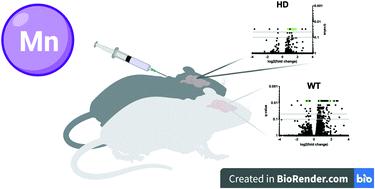当前位置:
X-MOL 学术
›
Metallomics
›
论文详情
Our official English website, www.x-mol.net, welcomes your
feedback! (Note: you will need to create a separate account there.)
Huntington's disease genotype suppresses global manganese-responsive processes in pre-manifest and manifest YAC128 mice.
Metallomics ( IF 2.9 ) Pub Date : 2020-05-12 , DOI: 10.1039/d0mt00081g Anna C Pfalzer 1 , Jordyn M Wilcox 2 , Simona G Codreanu 3 , Melissa Totten 4 , Terry J V Bichell 1 , Timothy Halbesma 1 , Preethi Umashanker 1 , Kevin L Yang 1 , Nancy L Parmalee 5 , Stacy D Sherrod 3 , Keith M Erikson 4 , Fiona E Harrison 6 , John A McLean 3 , Michael Aschner 5 , Aaron B Bowman 7
Metallomics ( IF 2.9 ) Pub Date : 2020-05-12 , DOI: 10.1039/d0mt00081g Anna C Pfalzer 1 , Jordyn M Wilcox 2 , Simona G Codreanu 3 , Melissa Totten 4 , Terry J V Bichell 1 , Timothy Halbesma 1 , Preethi Umashanker 1 , Kevin L Yang 1 , Nancy L Parmalee 5 , Stacy D Sherrod 3 , Keith M Erikson 4 , Fiona E Harrison 6 , John A McLean 3 , Michael Aschner 5 , Aaron B Bowman 7
Affiliation

|
Manganese (Mn) is an essential micronutrient required for the proper function of several enzymes. Accumulating evidence demonstrates a selective decrease of bioavailable Mn in vulnerable cell types of Huntington's Disease (HD), an inherited progressive neurodegenerative disorder with no cure. Amelioration of underlying pathophysiology, such as alterations in Mn-dependent biology, may be therapeutic. We therefore sought to investigate global Mn-dependent and Mn-responsive biology following various Mn exposures in a mouse model of HD. YAC128 and wildtype (WT) littermate control mice received one of three different Mn exposure paradigms by subcutaneous injection of 50 mg kg−1 MnCl2·4(H2O) across two distinct HD disease stages. “Pre-manifest” (12-week old mice) mice received either a single (1 injection) or week-long (3 injections) exposure of Mn or vehicle (H2O) and were sacrificed at the pre-manifest stage. “Manifest” (32-week old) mice were sacrificed following either a week-long Mn or vehicle exposure during the manifest stage, or a 20-week-long chronic (2× weekly injections) exposure that began in the pre-manifest stage. Tissue Mn, mRNA, protein, and metabolites were measured in the striatum, the brain region most sensitive to neurodegeneration in HD. Across all Mn exposure paradigms, pre-manifest YAC128 mice exhibited a suppressed response to transcriptional and protein changes and manifest YAC128 mice showed a suppressed metabolic response, despite equivalent elevations in whole striatal Mn. We conclude that YAC128 mice respond differentially to Mn compared to WT as measured by global transcriptional, translational, and metabolomic changes, suggesting an impairment in Mn homeostasis across two different disease stages in YAC128 mice.
中文翻译:

亨廷顿病基因型抑制显性前和显性 YAC128 小鼠的整体锰反应过程。
锰 (Mn) 是多种酶正常发挥功能所需的必需微量营养素。越来越多的证据表明,亨廷顿舞蹈病 (HD) 是一种无法治愈的遗传性进行性神经退行性疾病,其脆弱细胞类型中的生物可利用锰会选择性减少。改善潜在的病理生理学,例如改变锰依赖性生物学,可能具有治疗作用。因此,我们试图在 HD 小鼠模型中研究各种锰暴露后的整体锰依赖性和锰反应生物学。YAC128 和野生型 (WT) 同窝对照小鼠通过皮下注射 50 mg kg -1 MnCl 2 ·4(H 2 O) 接受三种不同的锰暴露范例之一,跨越两个不同的 HD 疾病阶段。“预表现”(12周龄小鼠)小鼠接受单次(1次注射)或为期一周(3次注射)的Mn或媒介物(H 2 O)暴露,并在预表现阶段被处死。“显性”(32周龄)小鼠在显性阶段进行为期一周的锰或媒介物暴露,或在显性前阶段开始进行为期20周的慢性(每周注射2次)暴露后处死小鼠。在纹状体中测量组织 Mn、mRNA、蛋白质和代谢物,纹状体是 HD 中对神经退行性疾病最敏感的大脑区域。在所有锰暴露范例中,尽管整个纹状体锰水平相当,但预显性 YAC128 小鼠表现出对转录和蛋白质变化的抑制反应,显性 YAC128 小鼠表现出抑制代谢反应。我们得出的结论是,通过整体转录、翻译和代谢组学变化测量,与 WT 相比,YAC128 小鼠对 Mn 的反应存在差异,表明 YAC128 小鼠在两个不同疾病阶段的 Mn 稳态受损。
更新日期:2020-05-12
中文翻译:

亨廷顿病基因型抑制显性前和显性 YAC128 小鼠的整体锰反应过程。
锰 (Mn) 是多种酶正常发挥功能所需的必需微量营养素。越来越多的证据表明,亨廷顿舞蹈病 (HD) 是一种无法治愈的遗传性进行性神经退行性疾病,其脆弱细胞类型中的生物可利用锰会选择性减少。改善潜在的病理生理学,例如改变锰依赖性生物学,可能具有治疗作用。因此,我们试图在 HD 小鼠模型中研究各种锰暴露后的整体锰依赖性和锰反应生物学。YAC128 和野生型 (WT) 同窝对照小鼠通过皮下注射 50 mg kg -1 MnCl 2 ·4(H 2 O) 接受三种不同的锰暴露范例之一,跨越两个不同的 HD 疾病阶段。“预表现”(12周龄小鼠)小鼠接受单次(1次注射)或为期一周(3次注射)的Mn或媒介物(H 2 O)暴露,并在预表现阶段被处死。“显性”(32周龄)小鼠在显性阶段进行为期一周的锰或媒介物暴露,或在显性前阶段开始进行为期20周的慢性(每周注射2次)暴露后处死小鼠。在纹状体中测量组织 Mn、mRNA、蛋白质和代谢物,纹状体是 HD 中对神经退行性疾病最敏感的大脑区域。在所有锰暴露范例中,尽管整个纹状体锰水平相当,但预显性 YAC128 小鼠表现出对转录和蛋白质变化的抑制反应,显性 YAC128 小鼠表现出抑制代谢反应。我们得出的结论是,通过整体转录、翻译和代谢组学变化测量,与 WT 相比,YAC128 小鼠对 Mn 的反应存在差异,表明 YAC128 小鼠在两个不同疾病阶段的 Mn 稳态受损。










































 京公网安备 11010802027423号
京公网安备 11010802027423号